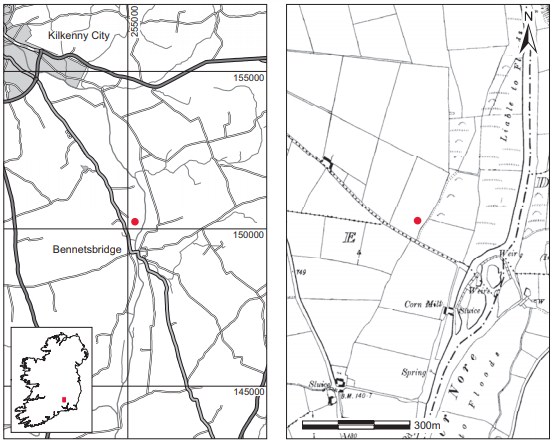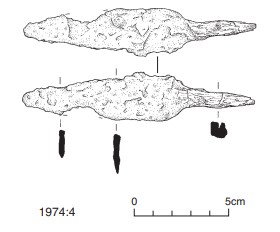1974:073 - SHEASTOWN, CO. KILKENNY, Kilkenny
County: Kilkenny
Site name: SHEASTOWN, CO. KILKENNY
Sites and Monuments Record No.: SMR KK024-030SMR KK024-029SMR KK024-001
Licence number: E1102
Author: ELLEN PRENDERGAST
Author/Organisation Address: —
Site type: Iron Age and early medieval graves, c. 300 BCc. AD 1200
Period/Dating: —
ITM: E 725446m, N 715053m
Latitude, Longitude (decimal degrees): 53.171158, -6.123634
Introduction
During quarrying operations in January 1974 human remains were discovered in a sandpit near Kilkenny City, Co. Kilkenny. Bone was noticed in several places on the surface of the sand deposit where the topsoil had been cleared. The bulldozer driver rescued a number of skulls and long bones and informed his employer of the find. The Garda Síochána at Bennetsbridge were then informed. The site was visited by the Gardaí, who then informed the NMI. A twoday excavation was carried out by Ellen Prendergast. The human remains from the site were examined by Professor Erskine.
Location (Fig. 4.27)
The site was in the townland of Sheastown, east Co. Kilkenny.60 It lay at an altitude of c. 50m above sea level very close to the west bank of the River Nore, close to the border between Sheastown and Killree townlands. There is no indication of the sandpit on either edition of the OS 6in. sheets, and there appears to have been very little surface indication of its presence. According to the excavator, there was no local history attached directly to the site of the burials, but an enclosure site is recorded adjacent to the burials and there is an ecclesiastical site just over 1km to the north.61 On the opposite side of the River Nore is Dunbell Big townland, where excavations of some of the many raths have produced large quantities of early medieval material.

Description of site
According to the finders, the topsoil was between 0.4m and 0.5m deep. It overlay the sand deposit in the field and had been stripped down to the sand in the area surrounding the quarry. The bone was exposed over an area approximately 35m by 50m. The remains of four skeletons were recovered during excavation of this area. Four graves were excavated in total, all aligned west/east. They consisted of unlined shallow pits in the surface of the gravel deposit with traces of soil/clay covering still present. Grave 1 was 4m west of the edge of the pit. Grave 2 was immediately east of this, closer to the edge of the pit. Graves 3 and 4 were positioned further south. No information is available as regards the dimensions or shape of the graves.
The graves each contained a single extended inhumation burial, and some appear to have contained a number of other, apparently disarticulated, bones (1974:5). The burials all appear to be aligned west/east. Grave 1 contained a male, grave 2 a female, grave 3 a male and a female, and grave 4 probably two males. All of the bodies were supine and fully extended; where it could be observed, the arms were extended by the sides and the skull was to the west. One of the graves contained an associated artefact. A small, tanged iron knife was found alongside the left femur of the burial in grave 1, with the finger bones close to it. The point of the knife was pointed towards the feet of the skeleton. A sample of the human remains associated with the iron knife was submitted for radiocarbon dating and yielded a date of 1575±35 BP, which calibrates to 413–561.62

Tanged iron knife, 1974:4 (Fig. 4.28)
A small iron knife with a slender triangular blade with a single cutting edge and a flat, thick back. The cross-section of the blade is triangular. The blade is narrowed from its widest part to form a narrow tapered tang, centrally placed. The tang is rectangular in cross-section. The traces or impressions of the grain of what appears to have been a wooden handle may be seen in the rusty surface of the tang, running along its length. Found with skeleton 1 (in grave 1) by the left femur and close to the finger bones of an extended inhumation of a male individual.
Dimensions: overall length 123mm; maximum width of blade 22mm; maximum thickness of blade 5mm; length of tang 40mm; width of tang 8mm; thickness of tang 4mm.
Comment
The radiocarbon date obtained from bone from this site indicates that this cemetery is early medieval. As noted in the case of Killaree, it is unusual in an Irish context for early medieval burials to contain grave-goods but the occasional occurrence of artefacts such as iron knives has been recorded (this volume, pp 70–2)
HUMAN REMAINS
C.A. ERSKINE63
The number 1974:5 was applied to all human remains from the site.
Unstratified bone
Bones comprise large pieces of one female and five male skeletons of individuals aged 25–30 years. All parts of skeleton represented. Complete vaults of three skulls and nearly complete female facial skeleton, which can be fitted to one of the vaults. Only feature to be noted is presence of Wormian bones and an unusually deep maxilla, but not abnormal. Well-marked nuchal lines on two skulls. Well-preserved fragments of limb bones. Two fragments of well developed scapulae and parts of male pelvis. Relatively few fragments of vertebrae, ribs and hand and foot bones.
Grave 1
Small collection of mainly limb bone fragments of male skeleton. Few hand bones—lunate, scaphoid and trapezoid and a few phalanges. Except for fragments of laminae, vertebrae absent.
Grave 2
Fairly large fragments of young female skeleton, adult and of small stature. Large pieces of two parietal, two temporal and occipital bones. Fragments of mandible and molar teeth with little wear. Parietal bones show post-mortem pitting and erosion. Few fragments of hand/foot bones and small fragments of ribs.
Grave 3
Collection of fairly large fragments of limb bones of at least two skeletons. Numerous smaller fragments (2–3cm) of male skeleton of individual of 20–25 years. Female clavicle fragment. Femoral head, fragments of skull—occipital, petrous temporal and maxilla, mandible with teeth showing little wear. At least three small fragments of skull are cremated.
Grave 4
Eight large fragments of human femur, tibia and humerus of two individuals, probably male.
60. Parish of Kilferagh, barony of Shillelogher. SMR KK024-030——. IGR 255237 150231.
61. The enclosure site is a recorded monument, SMR KK024-029——, IGR 25510 15067. The ecclesiastical remains consist of a church and graveyard, SMR KK024-001——.
62. GrA-24361.
63. Professor C.A. Erskine labelled the remains A–D but these have been changed to correspond with the grave
numbers 1–4.
